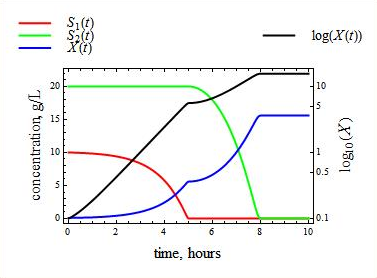Team:Imperial College London/Temporal Control
From 2009.igem.org

Contents |
 Temporal Control
Temporal Control
Engineering Approach to Temporal Control
This temporal control platform showcases our engineering approach in the E.ncapsulator project. We’ve made our entire system modular. Each module can essentially be pictured as a blackbox with one temporal control input and one output. Therefore, each module is linked to the next module by temporal control. Temporal control has allowed us to create a system that can be reused in other projects in synthetic biology. It is in fact a novel engineering approach that is both reusable and elegant.
In our temporal control system, we have employed 3 kinds of temporal control:
- Chemoinduction:
Production of the protein of interest is triggered by the addition of a chemical.
In our case, we have chosen IPTG. IPTG will be added when the cell density is deemed sufficient for protein production (Module 1) to begin.
- Autoinduction:
When glucose levels have fallen to nearly 0, encapsulation (Module 2) will begin automatically in response.
In our case, this will allow a sufficient amount of protein production to have taken place, before the cell focuses its resources on encapsulation.
- Thermoinduction:
Genome deletion is triggered by the increase of temperature. This is the last step of the temporal control system.
In our case, thermoinduction was necessary, as chemical induction may be blocked by the presence of the capsule (that inhibits diffusion).
Timeline of Temporal Control
This timeline shows the sequence of occurrence of these events:
 about the timeline and its explainations, and click here to see our testing construct.
about the timeline and its explainations, and click here to see our testing construct.
Our Results
We have modelled autoinduction by a number of models, and we hope that experimental results will confirm which model is most applicable to our system.
The first of our diauxic growth models is a cybernetic model developed by Kompala et al [1]. Diauxic growth occurs when glucose is taken up preferentially instead of the secondary carbon source present. This results in an exponential growth, follow by a stationary growth phase when glucose runs out. This will be followed by another exponential growth as the cells now consume the secondary carbon source.
This model shows that glucose (S1) is used up before the secondary carbon source (S2). During this phase, the population (X) is in exponential grow until glucose (S1) runs out. This is followed by a stationary growth phase, and finally the population enters a second exponential growth phase as they start uptaking the secondary carbon source (S2).
Click here to learn more about our simulations and models on autoinduction!
References
[1]Kompala, D.S., D. Ramkrishna and G.T. Tsao, "Cybernetic modeling of microbial growth on multiple substrates," Biotechnology and Bioengineering 26 :1272-1281 (1984).
Project Tour


For more details of the temporal control of the system, see the tabs below.
Temporal Control Contents






 "
"





